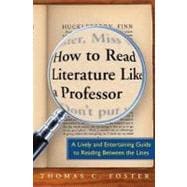What does it mean when a fictional hero takes a journey?. Shares a meal? Gets drenched in a sudden rain shower? Often, there is much more going on in a novel or poem than is readily visible on the surface—a symbol, maybe, that remains elusive, or an unexpected twist on a character—and there's that sneaking suspicion that the deeper meaning of a literary text keeps escaping you.
In this practical and amusing guide to literature, Thomas C. Foster shows how easy and gratifying it is to unlock those hidden truths, and to discover a world where a road leads to a quest; a shared meal may signify a communion; and rain, whether cleansing or destructive, is never just rain.
Ranging from major themes to literary models, narrative devices, and form, How to Read Literature Like a Professor is the perfect companion for making your reading experience more enriching, satisfying, and fun.
“A smart, accessible, and thoroughly satisfying examination of what it means to read a work of literature. Guess what? It isn’t all that hard, not when you have a knowledgeable guide to show the way. Dante had his Virgil; for everyone else, there is Thomas Foster.”- Nicholas A. Basbanes, author of A Gentle Madness, Patience & Fortitude, and Among The Gently Mad








